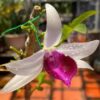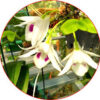## Essential Information for Participating in Dendrobium Orchid Exhibitions

Participating in a Dendrobium orchid exhibition can be an exciting and enriching experience for both novice and seasoned orchid enthusiasts. Dendrobium orchids, known for their stunning blooms and diverse varieties, have garnered a dedicated following around the world. Exhibitions provide a platform for growers to showcase their beautiful plants, connect with other enthusiasts, and learn more about the art and science of orchid cultivation. This guide will cover essential aspects to consider when participating in a Dendrobium orchid exhibition, including preparation, display techniques, and networking opportunities.
### 1. Understanding Dendrobium Orchids
#### 1.1 Overview of Dendrobium Orchids
Dendrobium orchids are one of the largest genera in the orchid family, with over 1,800 species. They are characterized by their unique growth habits, stunning flowers, and ability to thrive in various environmental conditions. Understanding the specific characteristics and requirements of Dendrobium orchids will help you better prepare for the exhibition.
#### 1.2 Popular Dendrobium Varieties
Before participating in an exhibition, it is beneficial to familiarize yourself with popular Dendrobium varieties. Some of the most sought-after include:
– **Dendrobium nobile**: Known for its fragrant, showy flowers that bloom in clusters.
– **Dendrobium phalaenopsis**: Recognized for its large, flat flowers that resemble those of the Phalaenopsis orchid.
– **Dendrobium kingianum**: A compact species that produces vibrant flowers in shades of purple, pink, and white.
Researching these varieties will help you make informed choices about which plants to exhibit and how to care for them.
### 2. Preparing for the Exhibition
#### 2.1 Selecting Your Orchids
Choosing the right Dendrobium orchids to display is crucial for making a positive impression. Here are some tips for selecting your plants:
– **Health and Vigor**: Select healthy plants with strong roots and vibrant foliage. Avoid any that show signs of disease or pest infestations.
– **Stage of Bloom**: Consider the bloom stage of your orchids. Plants that are just beginning to flower or are in full bloom will attract more attention than those that are past their prime.
– **Variety Diversity**: Displaying a range of varieties can showcase your knowledge and expertise, making your exhibit more appealing to judges and attendees.
#### 2.2 Grooming and Care
Proper grooming is essential for presenting your orchids at their best. Here are some grooming tips:
– **Cleaning Leaves**: Wipe the leaves with a damp cloth to remove dust and debris. This not only improves the appearance but also allows the plant to photosynthesize more effectively.
– **Trimming Dead Flowers**: Remove any dead or wilted flowers to maintain a clean and attractive display.
– **Checking for Pests**: Inspect your plants for pests or diseases, and treat them as necessary before the exhibition.
#### 2.3 Choosing the Right Display Method
How you display your Dendrobium orchids can significantly impact their visual appeal. Consider the following display options:
– **Traditional Pots**: Use decorative pots that complement the colors of your orchids. Ensure the pots have proper drainage to maintain healthy root systems.
– **Hanging Displays**: Some Dendrobium varieties benefit from being displayed in hanging baskets. This method can enhance visibility and showcase the plant’s natural growth habit.
– **Terrariums**: For a unique presentation, consider creating a terrarium environment that highlights the orchids’ natural habitat.
### 3. Logistics of the Exhibition
#### 3.1 Registration Process
Before attending an exhibition, familiarize yourself with the registration process. Each exhibition may have different rules and deadlines. Key points to consider include:
– **Entry Forms**: Complete all necessary entry forms accurately and submit them before the deadline.
– **Fees**: Be aware of any registration fees associated with the exhibition and budget accordingly.
– **Categories**: Understand the different categories available for judging. Categories may include best bloom, best pot, and best display, among others.
#### 3.2 Transportation and Setup
Transporting your orchids safely to the exhibition is critical to their well-being. Follow these tips:
– **Packing**: Use sturdy boxes or containers to protect your orchids during transport. Ensure they are well-ventilated to prevent moisture buildup.
– **Temperature Control**: Maintain appropriate temperatures during transit. Avoid leaving plants in hot or cold vehicles for extended periods.
– **Setup Time**: Arrive early to set up your display. This allows you time to adjust arrangements and ensure everything is in order before the exhibition begins.
### 4. During the Exhibition
#### 4.1 Engaging with Attendees
Exhibitions are an excellent opportunity to connect with fellow orchid enthusiasts and share your knowledge. Here are some tips for engaging with attendees:
– **Share Your Passion**: Be enthusiastic about your orchids and share information about their care, history, and unique characteristics.
– **Answer Questions**: Be prepared to answer questions from attendees about your plants, cultivation practices, and the exhibition experience.
– **Network**: Use this opportunity to network with other growers and enthusiasts. Exchange contact information and consider joining local orchid societies for ongoing engagement.
#### 4.2 Participating in Judging
If your orchids are entered for judging, it’s essential to understand the judging process:
– **Judging Criteria**: Familiarize yourself with the criteria judges use to evaluate orchids. Common factors include health, bloom quality, presentation, and variety.
– **Feedback**: Be open to feedback from judges. Their insights can help you improve your orchid-growing skills for future exhibitions.
### 5. Post-Exhibition Considerations
#### 5.1 Caring for Your Orchids After the Exhibition
After the exhibition, it’s crucial to continue caring for your orchids properly. Here are some post-exhibition care tips:
– **Assess Stress Levels**: Orchids may experience stress from being transported and displayed. Monitor their health closely after the event.
– **Adjust Watering**: Water your orchids as needed based on their condition and environmental changes after the exhibition.
– **Continue Grooming**: Remove any dead flowers or leaves that may have accumulated during the event.
#### 5.2 Reflecting on the Experience
Take time to reflect on your exhibition experience. Consider the following:
– **What Worked Well**: Identify aspects of your preparation and display that were successful.
– **Areas for Improvement**: Recognize areas where you can improve for future exhibitions. This may include plant selection, display techniques, or engagement with attendees.
– **Planning for Future Exhibitions**: Use your experiences to inform your preparations for upcoming orchid exhibitions. Set goals for plant growth, display enhancements, and networking opportunities.
### 6. Conclusion
Participating in a Dendrobium orchid exhibition can be a rewarding experience that enhances your knowledge and appreciation of these beautiful plants. By understanding the characteristics of Dendrobium orchids, preparing effectively, and engaging with other enthusiasts, you can make the most of your exhibition experience. Whether you are showcasing your prized orchids or learning from fellow participants, exhibitions provide a valuable opportunity to celebrate the beauty and diversity of Dendrobium orchids. With the right preparation and mindset, you can create a memorable experience that will inspire your continued passion for these remarkable plants.

